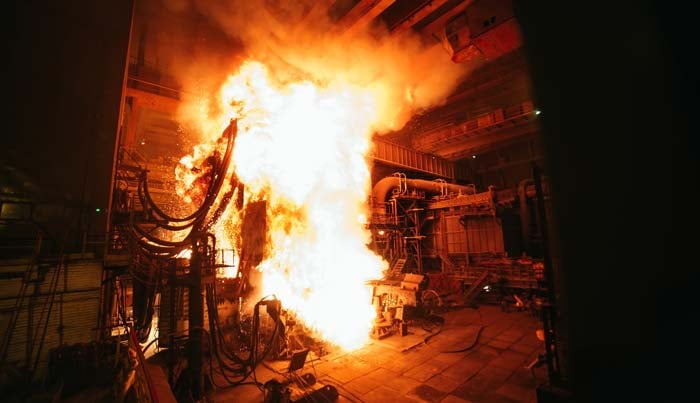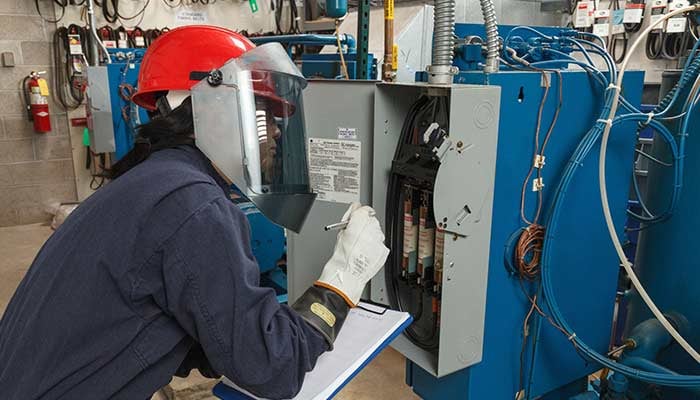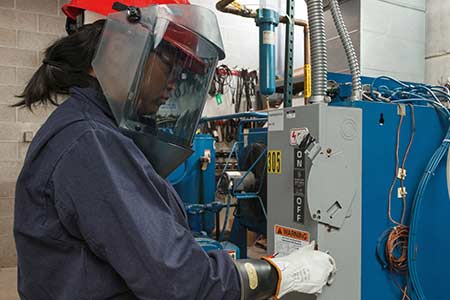The Arc Flash Risk Assessment: A Definitive Guide
There's no getting around it: employees who work on or around energized equipment or machinery are exposed to arc flash hazards daily while on the job. But with the right combination of detection and prevention, these hazards can be identified and avoided, or minimized if an event occurs. That's where an arc flash risk assessment comes in.
A thorough, accurate arc flash risk assessment ensures worker safety, first and foremost. But beyond that, a sustainably maintained assessment saves money in the long term. Explore key components of this important safety tool, including background, arc flash risk assessment requirements, process, and a review of additional compliance needs.
Want to see if your facility meets current arc flash standards?
Take the AssessmentThe fundamentals of an arc flash
Dangerous and instantaneous - arc flash events are serious business
An arc flash is a release of energy through an electrical arc. This happens when an electrical current passes through air between ungrounded conductors or between ungrounded and grounded conductors.
In simpler terms, the effects of an arc flash event mirror that of a bomb. Energy is released in the form of heat, intense ultraviolet and infrared light, blast pressure waves, and intense sound waves. Smoke, toxic fumes, molten metal, and flying shrapnel may accompany the electrical event. Any person in proximity to an arc flash blast can suffer injuries as severe as burns, collapsed lungs, loss of vision, ruptured eardrums, soft tissue injuries, broken bones, or even death.

Common causes
Human error
- Accidental contact of energized circuit parts with conductive tools or body parts
- Installation mistakes, such as incorrect wiring and improper labeling
- Lack of training
- Missed signals of possible imminent equipment failure, such as excessive heat or noise
- Failure to take steps to prevent an arc flash
Equipment failures
- Loose connections causing arcing or overheating
- An improper equipment rating for the system in which it is installed
- The breakdown of insulation on cables or other energized parts allowing current to flow outside its intended path
- Poor maintenance resulting in rust, dust, debris, condensation or exposure to water
- Transient events from utilities, lightning or events generated from within the facility
Codes and standards detail arc flash compliance
Arc flash compliance comes from two organizations that are responsible for regulating and providing guidance on arc flash risk assessment requirements.
OSHA 1910.333(opens in a new tab) — what you must do
Under 29 CFR 1910.333, OSHA requires employers to identify hazards in the workplace, train their employees to safely work around these hazards, and to provide the proper PPE for the job they are expected to perform. OSHA advises employers to refer to NFPA 70E as the standard for how to meet their requirements.
NFPA 70E(opens in a new tab) — how you do it
NFPA 70E informs the OSHA standard and guides facilities to electrical safety and compliance. This includes how to:
- Conduct an arc flash risk assessment and hazard analysis
- Determine potential arc flash incident energy levels
- Select PPE
- Label equipment
- Review the assessment
- Determine training content and frequency
The arc flash risk assessment builds the foundation for success
An arc flash risk assessment is vitally important to worker health and safety. This critical assessment is required under NFPA 70E and provides four key findings:
- Identifies hazards
- Estimates the likelihood of hazard occurrence
- Outlines potential severity of injuries associated with each hazard
- Determines the Personal Protective Equipment (PPE) required to work safely around the potential hazard
These assessment findings then inform the steps, information, and procedures you'll need to implement to be compliant under OSHA 29 CFR 1910.333(opens in a new tab).

Life cycle of an arc flash risk assessment
 Qualified Electrical Worker (QEW) Training
Qualified Electrical Worker (QEW) Training
Required by NFPA 70E
Under NFPA 70E, qualified employees must be able to apply their arc flash safety training on the facility floor. Brady’s 8-hour QEW Training brings you into compliance and takes a custom, more-effective approach by incorporating both NFPA guidelines and your companyspecific arc flash requirements. Topics include shock hazards, codes, regulation, definitions, PPE, approach boundaries and labels.
 Arc Flash Risk Assessment
Arc Flash Risk Assessment
Required by NFPA 70E
The arc flash risk assessment report will identify:
- Arc flash hazards and incident energy boundaries
- Likelihood of an arc flash and the injuries it may cause
- Severity of potential injuries
- Protective measures needed, including PPE
- Equipment to be labeled
Ongoing Assessment Updates
No matter how big or small, if your facility changes, it could affect or even outdate your assessment. A little work occasionally goes a long way over time. Brady electrical engineers can work with you, on-site or remotely, to assess if facility changes require assessment updates.
 QEW Training Check-in
QEW Training Check-in
NFPA 70E requires employee retraining every three years
Do you have employees who have gone through QEW training in the last three years?
Yes — Brady’s 4-hour Refresher Course is designed for qualified employees who have strong familiarity with NFPA 70E standards and working with electrical equipment.
No — Brady’s 8-hour QEW Training is designed for qualified employees who have:
- never been trained, or
- need additional coverage of the basics of electrical safety
 Assessment Review Last Chance!
Assessment Review Last Chance!
NFPA 70E requires that assessments be reviewed at intervals not to exceed five years.
Arc Flash Assessment Review service dispatches engineers to your site to review your assessment and facility for changes, note affected equipment, and detail next steps.
Time for a New Assessment?
If it’s been more than five years since your initial Arc Flash Risk Assessment and review, it’s time to have a new assessment performed. In addition to bringing you into compliance, it ensures coverage of your entire facility and everything that may have changed.
 QEW Training Check-in
QEW Training Check-in
NFPA 70E requires employee retraining every three years
It’s time to retrain. Refer to your training records to determine if refresher training and/or initial training is needed.
Arc flash risk assessment steps, studies and results
Comprised of data collection and a series of studies, the arc flash risk assessment identifies arc flash hazards in an electrical system as well as the adjustments, labeling, and PPE needed to mitigate them. The following is a high-level overview of the arc flash risk assessment process and conveys key milestones simply and broadly. Your specific assessment will be an in-depth process of data collection, analysis, and reporting.
- Step 1: The Short Circuit Study is the first step of arc flash calculation. This reveals the available fault current that would flow to each piece of equipment in the event of a short circuit – the most common cause of arc flash. All data collected as part of this process is recorded in your final report as System Input Data.
- Step 2: The Device Evaluation compares the available fault current to the interrupting capacity of the breaker or fuses in the circuit. If the available fault current is higher than the interrupting capacity of the breaker or fuse, it’s considered over-duty and may not open in a fault scenario. If it's over duty, and based on the settings, it should trip the breaker which would stop the flow of electrical energy.
- Step 3: After a breaker is determined as sufficiently rated to interrupt the fault, time needed to perform its intended function is determined. Time may be a function of trip settings that are on the breaker. This information is documented in your report’s Settings Table.
- Step 4: How much current flows and how long it flows for then reveals the total amount of energy released during an arc flash event (commonly referred to as a fireball). All energy (calories) that passes through an imaginary plane 18 inches (working distance) from the arcing source (surface area in cm^2) is heat that a worker could be exposed to. Recommendations are then made to adjust trip settings to reduce the total energy and arc flash hazard a worker could be exposed to.
Once complete, all information is packaged up in your report and communicated to employees via Arc Flash Labels and One-Line Diagrams. If you’re interested in a more detailed look at the process for your facility, reach out to a Brady Safety Services expert to discuss the process for your facility.
Regular assessment reviews sustain long-term success
After an arc flash risk assessment has been completed, it’s important to maintain the accuracy of the data in the study. Changes in utility contribution, installation or removal of machinery, and renovations can impact available fault currents. For this reason, arc flash risk assessments are required to be updated in intervals not to exceed five years or when significant changes are made to the system.
Validating and performing ongoing updates
This process generally follows four steps:
- Step 1: An engineer comes on-site to evaluate the current arc flash labeling and verify the accuracy of the previous arc flash assessment by completing spot checks on equipment, settings of overcurrent protective devices, and PPE in use by employees.
- Step 2: While on-site, the engineer reviews job assessment checklists, energized work permits, and the overall written safety program to determine if it is in compliance with NFPA 70E.
- Step 3: The engineer conducts confidential interviews with employees who work directly on electrical equipment to determine if they see any gaps in electrical safety.
- Step 4: The engineer compiles the audit information, identifies issues of non-compliance, and makes recommendations to improve electrical safety.

Additional arc flash assessment requirements to be compliant
Having an arc flash risk assessment and labels is only part of arc flash compliance with OSHA, NFPA, and the Institute of Electrical and Electronics Engineers (IEEE). Other steps must be taken to be fully compliant.
Training

Employees who face exposure to electrical hazards must be trained in arc flash and electrical hazards in accordance with NFPA 70E. Full-day training is recommended for employees who have not received training in the past. Annual refresher courses can be conducted by the safety department or management at the employee’s facility. Four-hour refresher training courses are available for employees who have received the full-day training more than three years ago.
Written Safety Program

Employers must have a written safety program dealing specifically with electrical hazards. This program must be reviewed annually. Documentation of an annual review must be kept. Any changes in industry standards must be implemented in the written safety program. This safety program must also include a pre-job briefing checklist and an energized work permit.
PPE

Employees who will be working on, or near, electrical hazards must be provided with PPE appropriate for the job being performed and for the body parts involved in the work being performed. The PPE must be provided at no cost to the employee and shall be maintained and repaired as needed.
Insulated Tools

When working on, or around, energized electrical equipment, employees must use insulated tools. These tools should be rated at least 1000V. A good practice is to use two-part insulation. This provides a visual indication of outer layer damage allowing the tool to be taken out of service before issues arise.
Key considerations when planning an arc flash risk assessment
Dedicated engineers and engineer autonomy
Some companies rely on third parties, such as electrical contractors, to collect the data needed to complete an arc flash assessment. This method risks employing a contractor who may not be familiar with what data needs to be collected for an arc flash risk assessment, however. Instead, consider dedicated engineers.
A dedicated engineer (or team of engineers) can execute each step of the assessment from start to finish, including data collection, calculations, reporting, and label installation. This reduces discrepancies in what is collected versus what is documented. Their in-depth knowledge of the strengths and weaknesses within a system will be conveyed thoroughly at each step.
Further, engineer autonomy creates a more efficient process. Autonomous engineers are familiar with most pieces of equipment and can work alone, tackling all activities designed to be safely completed by one person. This limits the need for a maintenance technician or electrician to accompany the arc flash engineer.
When considering your options for an arc flash risk assessment, always ask the provider to clearly explain your responsibilities as the client. Questions to consider asking include:
- Will I need to assign a resource?
- Will I need to hire a resource?
- Are you outsourcing or subcontracting any part of this project?
Engineered analysis method
NFPA 70E outlines two methods to determine arc flash hazards – the incident energy analysis and the category method. Incident energy analysis is a more thorough and accurate method, making it the preferred choice. Both methods require an accurate short-circuit study to be performed first.
- The incident energy analysis is a comprehensive method that involves quantifying and determining an arc flash hazard numerically for each bus. This information is used to identify PPE and an arc flash boundary adequate for each bus.
- The category method uses tables to assign a category number to each bus. It is often very conservative.
Evaluate, complete and sustain your arc flash risk assessment with Brady
Arc flash risk assessments are complex studies that require a solid foundation in the latest performance standards and the application of that information to the specific work environment. Brady offers a number of ways to maintain electrical safety and compliance, from start to finish and everything in between.

Your electrical safety partner
At the core of what we do isn't products, it's people. Brady's team of electrical safety professionals bring decades of experience to your unique project. We're passionate about what we do and who we do it for because we know our work directly affects lives and livelihoods.
Your arc flash risk assessment, done right
Dedicating internal resources to complete your NFPA arc flash risk assessment can not only be time-consuming, but require an investment in software and arc flash expertise. One miscalculation can result in inaccurate PPE protection, non-compliance, and even more time spent on rework. Our team of experts will complete your assessment, provide you with a detailed assessment report, including your single line diagram, and install the correct arc flash labels.
Your assessment, your documentation
When we complete our work, we pass on all the results and project files to you. After all, it's your safety and your business, and you should have every tool to succeed.
Training built for you
Under NFPA 70E, qualified employees must be able to apply their Arc Flash Safety Training on the facility floor. Brady offers multiple training options:
8-hour qualified electrical worker training
This brings you into compliance and takes a custom, more-effective approach by incorporating both NFPA guidelines and your company-specific arc flash requirements. Topics include shock hazards, codes, regulation, definitions, PPE, approach boundaries, and labels.
4-hour refresher course
This is designed for qualified employees who have strong familiarity with the NFPA standards and working with electrical equipment and have gone through QEW training within three years.
Sustaining your investment
If it's been over three years since your initial arc flash assessment, it's time to revisit. It could be the difference between making minor updates or performing a costly full new assessment. Brady electrical engineers can work with you, on-site or remotely, to assess if facility changes require assessment updates.
Labeling your way
Brady safety labeling and printing solutions do things others don't in ways they can't. This includes displaying electrical information in a way that's easier to read from further away, i.e., 240V, Fed from MCC-5.
